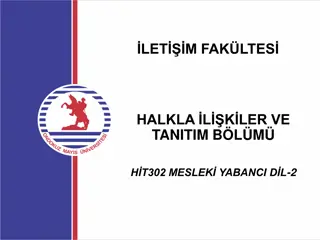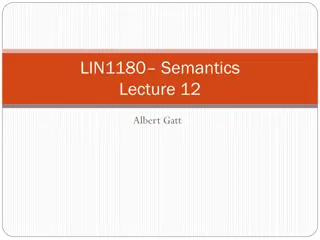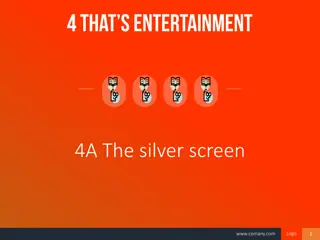Learn Past Continuous Tense - Grade 6 English Lesson
This Grade 6 English lesson focuses on understanding and correctly using the past continuous tense. It covers the rules for forming the past continuous tense, examples of its usage, and an assessment to test comprehension. Students will practice talking about actions happening at specific times in t
4 views • 6 slides
Fashion Vocabulary and Future Tense Practice Exercises
Practice exercises for learning fashion vocabulary and using the future tense. Activities include identifying clothing items, forming future tense sentences, unscrambling words, asking and answering questions about clothing preferences, and completing charts based on listening exercises. Improve you
2 views • 10 slides
Understanding Tense in English Grammar
Explore the different types of tenses such as Present, Past, and Future Tense along with their classifications like Present Indefinite Tense, Past Continuous Tense, and Future Perfect Tense. Learn how to form positive and negative sentences in each tense with examples. Enhance your knowledge of Engl
2 views • 19 slides
Learning Future Simple Tense in English Lesson
Learn how to use the future simple tense correctly in English through a lesson focused on planning a trip to France. The lesson includes reading exercises, grammar rules, error correction practice, dialogues, and more to help you understand and apply the future simple tense effectively.
2 views • 7 slides
Learning the Future Simple Tense with Regular Verbs in French
Explore how to form, recognize, and use the future simple tense in French for talking about your plans using regular verbs. Understand the differences between le futur proche and le futur simple and learn the endings for conjugating verbs in the future tense.
0 views • 8 slides
Examples of Passive Voice and Simple Present Tense in English
Explore various examples of passive voice and simple present tense usage in English sentences, including questions and statements with explanations. Understand how to form passive voice and identify simple present tense sentences through practical examples.
0 views • 15 slides
Mastering Reported Speech: Simple Present to Simple Past
Learn how to convert statements from the simple present tense to the simple past tense in reported speech with clear examples. Practice exercises are provided for better understanding, covering various sentence structures including negative sentences and present continuous to past continuous transfo
0 views • 45 slides
Understanding Regular and Irregular Verbs in Simple Past Tense
Learn how to form the simple past tense with regular and irregular verbs. Regular verbs end in "-ed," while irregular verbs have unique past tense forms. Examples and images illustrate the differences, helping you master past tense verb usage effortlessly.
0 views • 11 slides
Understanding Tense in Communication Skills Course - Key Features and Clarifications
Explore the significance of tense in communication skills with Dr. Sarla Verma's virtual class for Diploma 1st-year students. Learn about verb forms, concepts of time, simple present tense, and highlights of present simple and continuous tenses. Understand temporary and permanent situations through
2 views • 24 slides
Understanding the Past Perfect Tense in English Grammar
The Past Perfect Tense is used to talk about actions completed before a certain point in the past, emphasizing the sequence of events. This tense follows the structure of "had + past participle" and is crucial for expressing events that happened earlier than others in a narrative. Knowing how to for
0 views • 27 slides
Understanding Future Continuous Tense in English Grammar
Future Continuous Tense is used to describe ongoing actions or events in the future. It signifies that something will be happening continuously over a period of time ahead. Learn about forming sentences, asking questions, and using negatives in the Future Continuous Tense with examples. Enhance your
1 views • 4 slides
Understanding Simple Past Tense in English: Rules and Examples
The simple past tense is a fundamental form in Modern English used to describe past events. It involves regular verbs adding "-ed" and irregular verbs having different forms. The construction of the simple past helps distinguish it from other past tense forms like past perfect and past progressive.
0 views • 33 slides
Understanding the Future Continuous Tense
The Future Continuous Tense is used to describe ongoing actions or events that will occur at a specific point in the future. It signifies continuous action over a period of time in the future. Questions, negatives, and examples are provided to enhance understanding of this tense.
0 views • 4 slides
Learn English Grammar - Present Continuous Tense Practice
This content provides a detailed overview and practice exercises on the Present Continuous Tense in English grammar, focusing on passive voice constructions. Various examples illustrate the formation and usage of this tense, reinforcing understanding through images and exercises. Whether you are a s
0 views • 12 slides
Understanding the Present Perfect Simple Tense and Its Usage
Learn about the basic rules, formation, and usage of the Present Perfect Simple tense in English. Explore how to form the tense, use shortened forms, understand when to use "have" and "has" with past participles, differentiate between Present Perfect and Past Simple, know when to use the Present Per
0 views • 11 slides
Understanding English Tenses: Present, Past, and Future
Understanding tenses in English grammar is essential for effective communication. Tenses indicate the time of an action or event, such as present, past, or future. This article explores the different types of tenses, including present tense, past tense, and future tense, along with examples to help
0 views • 22 slides
Understanding the Present Perfect Tense in English Grammar
The present perfect tense in English grammar is a combination of the present tense and perfect aspect used to express past events with present consequences. It is formed using the auxiliary verb "have" and the past participle of the main verb. This tense is essential for indicating completed actions
0 views • 27 slides
Understanding Future Progressive Tense in English Grammar
Future Progressive Tense, also known as Future Continuous Tense, is used to indicate actions that will be ongoing at a specific point in the future. This tense emphasizes the continuous nature of an action happening in the future. Learn how to form and use the Future Progressive Tense through exampl
0 views • 22 slides
Understanding Tense and Grammatical Aspect in Language
This lecture delves into the intricacies of tense and grammatical aspect, exploring concepts such as progressive/non-progressive, perfective/imperfective aspects across languages. It discusses the interaction between grammatical aspect and lexical aspect (Aktionsart), focusing on tense as a deictic
0 views • 43 slides
Mastering the Future Tense in Spanish
Learn how to use the future tense in Spanish to improve your language skills and achieve better grades. Explore the two future tenses in Spanish, the near future structure with "ir + infinitive," and the simple future with verb endings. Practice translating sentences to and from Spanish to strengthe
0 views • 9 slides
English Verb Tense Review: Simple Present and Simple Past
Simple Present Tense is used for habitual actions, unchanging truths, and general statements of fact. It is indicated by words like always, usually, and sometimes. Simple Past Tense is used for completed actions and past habits indicated by words such as yesterday and last night. The forms and indic
0 views • 46 slides
Learning Past Verbs and Present Perfect Tense
This content discusses past tense verbs through completing tables, giving examples, and exploring the present perfect simple tense with real-world scenarios. It covers verb conjugations in the past tense, such as went, ate, won, took, and swam, along with explanations and exercises related to the pr
1 views • 14 slides
Understanding Simple Present Tense and Its Usages
Simple Present Tense is used for habits, routines, and permanent truths. This tense follows a specific structure for positive, negative, and interrogative sentences. Through examples and exercises, learn how to correctly use Simple Present Tense in everyday conversations.
0 views • 8 slides
Understanding Simple Present Tense with Examples and Formation
Simple Present Tense is used to talk about actions that happen regularly or are true in the present. This tense is used for statements of fact, daily habits, schedules, opinions, and more. The formation includes affirmative, interrogative, and negative sentences. Examples and usage scenarios help in
0 views • 14 slides
Understanding Future Simple Tense in English Grammar
The Future Simple Tense in English is used to express decisions made at the moment of speaking, announce planned future events, show willingness or unwillingness for future actions, express thoughts, and talk about events certain to happen. It is often accompanied by adverbs to indicate timing. Ques
0 views • 11 slides
Understanding Future Tense in Grammar
Future tense in grammar signifies events that have not occurred yet but are expected to happen in the future. While English lacks a distinct future tense form, it expresses future events through auxiliary verbs like will, shall, and going to. Relative tense, on the other hand, compares time referenc
0 views • 28 slides
Understanding the Past Simple Tense in English Grammar
The past simple tense refers to actions that occurred at a specific time in the past and are now completed. This tense follows a specific rule where the subject is combined with a verb (regular or irregular) and a complement. Adverbs like "yesterday," "ago," and "last" are commonly used with past si
0 views • 9 slides
Understanding Past Simple Tense in English Grammar
The past simple tense is used to describe completed actions or events that happened at a specific time in the past. Regular verbs form the past simple by adding "-ed", while irregular verbs have unique past tense forms. The structure for negative and question forms involves the auxiliary verb "did".
0 views • 6 slides
Famous Failed Predictions and Future Simple Tense Exercises
Explore famous failed predictions from the past and practice constructing sentences in the future simple tense using "will" followed by the correct verb. The provided exercises cover historical misconceptions about wars, technology, astronomy, and prophecies. Test your grammar skills with these enga
0 views • 19 slides
Understanding Present Continuous Tense in English Grammar
Explore the present continuous tense in English grammar through examples and explanations. Learn how to form positive, negative, and question sentences in this tense, as well as common uses such as actions happening now, future plans, temporary situations, and habitual actions. Enhance your grasp of
0 views • 50 slides
Grammar Exercises: Passive Voice and Future Tense Practice
Practice passive voice and future tense with exercises focusing on forming sentences using verbs in the correct tense. Learn how to change active sentences to passive and use future forms of verbs. Enhance your grammar skills by completing the exercises and checking your answers.
0 views • 8 slides
Advanced Spanish Preterite Tense Irregular Verbs and Conjugations
Dive into advanced Spanish conversation with a focus on preterite tense irregular verbs and conjugations. Practice sentence translations, engage in conversation exercises using the preterite tense, learn new vocabulary, and review general notes for past tense usage in Spanish. Explore the conjugatio
0 views • 11 slides
Understanding the Present Perfect Tense in English Grammar
Explore examples of using the present perfect tense in English grammar, including how to discuss experiences, use of "never" and "ever," and distinguishing between past simple and present perfect. Learn how to correctly form sentences and ask questions in the present perfect tense.
0 views • 24 slides
Present Tense: Daily Activities & Information
Explore the present tense for daily routines, general knowledge, and current information in this informative content. Discover what activities are usually done on Saturday evenings and Sunday mornings, learn about the ministers in charge of Maritime and Fisheries Affairs and Agriculture, and get fam
0 views • 10 slides
Understanding the Present Perfect Continuous Tense
The Present Perfect Continuous Tense is used to emphasize the duration of an action that started in the past and continues up to the present, indicating ongoing actions with time expressions like 'for,' 'since,' 'all morning,' etc. Learn how to use this tense correctly and distinguish it from the Pr
1 views • 10 slides
English Grammar Exercises for Tense Practice
Improve your English grammar skills with exercises focusing on simple past tenses, present perfect tense, and various tense usage scenarios. Practice gap filling, verb forms, and sentence construction to enhance your language proficiency. Explore topics such as financial reporting, business logistic
0 views • 11 slides
Chinese Language Learning Objectives for 11th Week - Reviewing New Words and Future Tense
This instructional plan outlines the objectives for the 11th week of a Chinese language course. Students will review new vocabulary words and past tense, learn about the future tense, practice making sentences, and prepare for presentations. The content includes Monday's objectives, a review of new
0 views • 12 slides
Understanding Simple Past Tense in Grammar
In this file, we delve into the concept of simple past tense in grammar. Through examples and explanations, you will learn how to use the simple past tense to talk about completed actions in the past. The structure, usage, and importance of simple past tense are covered extensively to enhance your u
0 views • 30 slides
Understanding Simple Future Tense in English Grammar
Simple Future Tense is used to express actions that will happen in the future. It is formed using "will" or "be going to" and can also involve expressions like "shall." This tense is used for predictions, plans, willingness, and decisions made at the moment of speaking. Learn how to form affirmative
0 views • 20 slides
English Business Language Exercises: Direct vs Indirect Questions & Present Simple Tense
Explore exercises on direct and indirect questions, as well as the present simple tense in English business language. Practice forming questions and using present simple tense verbs in context. The exercises cover a range of question structures and verb conjugations, enhancing your English language
0 views • 38 slides







































